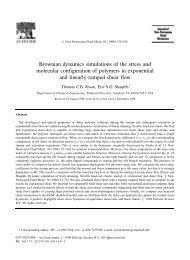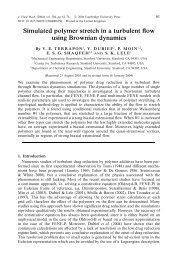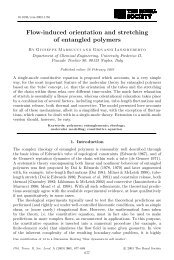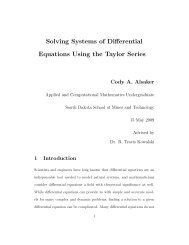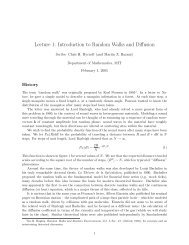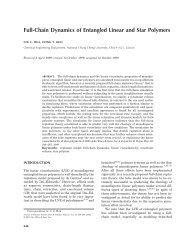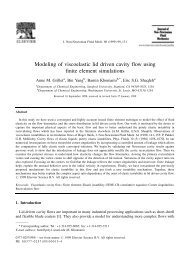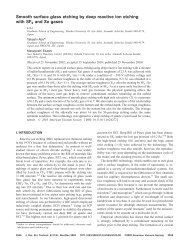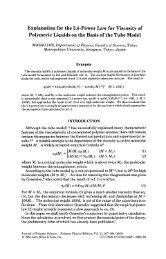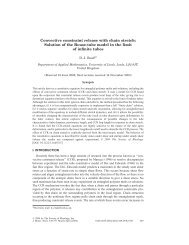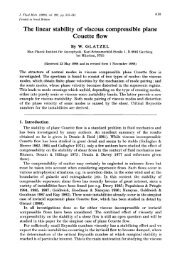A numerical study of the rheological properties of suspensions of ...
A numerical study of the rheological properties of suspensions of ...
A numerical study of the rheological properties of suspensions of ...
Create successful ePaper yourself
Turn your PDF publications into a flip-book with our unique Google optimized e-Paper software.
162 M. B. Mackaplow and E. S. G. Shaqfehstokeslet distributions to determine <strong>the</strong> fibre dipole tensors. These can be used wi<strong>the</strong>quations (1) and (3) to calculate <strong>the</strong> suspension stress. A typical simulation withM = 13 and 100 spheroidal inclusions in a cubic unit cell required about 5 minutes<strong>of</strong> CPU time on a CRAY C90 supercomputer. For each set <strong>of</strong> physical parameters,<strong>the</strong> equations were solved for 1&20 different particle configurations and <strong>the</strong> resultswere ensemble averaged.Even after taking advantage <strong>of</strong> <strong>the</strong> fact that HP(x) = Hp(-x), our simulationsstill required approximately (N x M)2/2 evaluations <strong>of</strong> HP(x). These evaluations arecomputationally intensive, even though <strong>the</strong>se are performed using Ewald sums, asdiscussed by Hasimoto (1959). We optimized this technique as a function <strong>of</strong> unit celldimensions in order to minimize <strong>the</strong> number <strong>of</strong> calculations required to achieve adesired accuracy in HP(x) using an algorithm developed by Mackaplow (1995) whichchooses <strong>the</strong> adjustable parameter, a, and <strong>the</strong> various limits <strong>of</strong> summation in <strong>the</strong> Ewaldsums, as a function <strong>of</strong> unit cell dimensions in order to minimize <strong>the</strong> number <strong>of</strong> termsrequired to get convergence. (See also Note added in prooL p. 185.)In order to generate <strong>suspensions</strong> <strong>of</strong> fibres, a random number generator is firstused to generate a fibre centre position within <strong>the</strong> unit cell, all positions being equallyprobable, and an orientation vector chosen from <strong>the</strong> appropriate distribution function.This fibre is placed in <strong>the</strong> unit cell. Then, <strong>the</strong> procedure is repeated, each time checkingif <strong>the</strong> generated fibre position will overlap with a fibre that has already been placed in<strong>the</strong> unit cell or one <strong>of</strong> its periodic extensions. If it does, <strong>the</strong> proposed fibre is rejected.For isotropically oriented inclusions, since a fibre is less likely to overlap with a nearbyfibre if <strong>the</strong> orientation vectors are similar (Doi & Edwards 1989), our procedure willlead to a certain degree <strong>of</strong> local orientation correlation within <strong>the</strong> unit cell. Since at<strong>the</strong> highest concentrations we <strong>study</strong>, <strong>the</strong> unit cells have dimensions less than 2 fibrelengths, <strong>the</strong>re is a risk that this procedure will lead to a strongly preferred suspensionorientations. To test for this, we divided <strong>the</strong> hemisphere <strong>of</strong> possible fibre orientations(taking advantage <strong>of</strong> <strong>the</strong> fore-aft symmetry <strong>of</strong> <strong>the</strong> fibres) into five equal-size regions.Then, histograms <strong>of</strong> <strong>the</strong> distributions were generated. We kept track <strong>of</strong> <strong>the</strong> maximumnumber <strong>of</strong> fibres in any one region. The average <strong>of</strong> this number was <strong>the</strong>n calculatedover <strong>the</strong> different configurations making up <strong>the</strong> ensemble average. This number, onaverage, was only 25% greater than <strong>the</strong> mean. More importantly, this percentagewas constant over a wide range <strong>of</strong> suspension concentrations (and thus unit cellsizes). Thus, we conclude that our suspension generation method did not stronglybias <strong>the</strong> orientation distribution in our model <strong>suspensions</strong>. The procedure to generatemodel <strong>suspensions</strong> with <strong>the</strong> orientation distribution found in steady-state shear flowis somewhat more complicated and will be discussed in $5.Our method <strong>of</strong> generating model <strong>suspensions</strong> does not lead to configurations inwhich all non-overlapping configurations are equally probable. Such a distributionwould be <strong>the</strong> equilibrium configuration for a Brownian suspension. However, for ournon-Brownian system, it is not clear if this is ever a relevant distribution.Never<strong>the</strong>less, we must question how much our results are dependent on <strong>the</strong>local fibre orientation correlations and centre-<strong>of</strong>-mass distributions produced byour particular generation algorithm. Insight into this can be gained by considering<strong>the</strong> corrections to <strong>the</strong> dilute <strong>the</strong>ory for two-body interactions and <strong>the</strong> semi-dilute<strong>the</strong>ories <strong>of</strong> Shaqfeh & Fredrickson (1990). These <strong>the</strong>ories explicitly consider particleinteractions. They also ignore excluded volume effects. Thus, <strong>the</strong>ir predictions arebased on no orientation correlations between particles. We note that it is <strong>the</strong> fibresclosest to a given ‘test fibre’ that will have <strong>the</strong> greatest effect on its stresslet. Theabove <strong>the</strong>ories predict <strong>the</strong> effect <strong>of</strong> particle interactions on <strong>the</strong> mean particle stresslet



